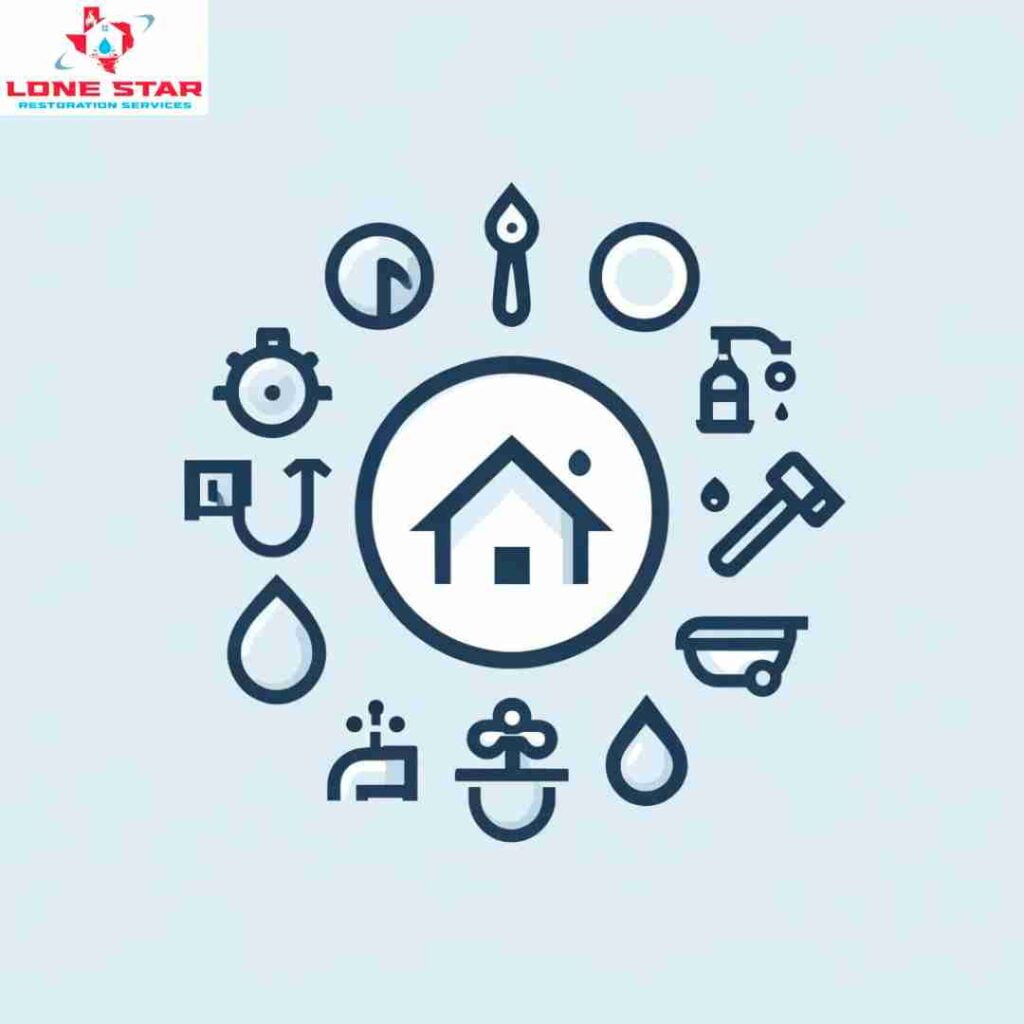Understanding the Top 5 Causes of Water Damage and Their Prevention
Water damage is one of the most common and costly issues homeowners face. Whether it’s a slow leak or a sudden flood, water damage can lead to significant structural problems, mold growth, and expensive repairs. Understanding the causes of water damage is crucial for preventing it and protecting your home. In this blog, we will explore the top five causes of water damage and provide practical tips on how to prevent them. By being aware of these potential hazards and taking proactive measures, you can safeguard your property and avoid the stress and expense that comes with water damage.
Cause 1: Leaking Pipes
Leaking pipes are a leading cause of water damage in homes. Over time, pipes can develop small leaks due to age, corrosion, or high water pressure. These leaks might start as minor drips but can escalate into significant problems if left unchecked. Common areas for leaks include under sinks, behind walls, and in basements, where pipes are often hidden from view.
Common Reasons for Pipe Leaks:
- Age: As pipes age, they can weaken and become more susceptible to leaks. Older homes are particularly at risk if the plumbing system hasn’t been updated.
- Corrosion: Metal pipes, especially those made of galvanized steel or iron, can corrode over time, leading to weak spots and eventual leaks.
- High Water Pressure: Excessively high water pressure can strain pipes, causing them to crack or burst under pressure.
Prevention Tips:
- Regular Inspections: Schedule routine plumbing inspections to catch and address potential issues early. A professional can identify weak spots, corrosion, and other signs of wear.
- Proper Insulation: Insulate exposed pipes, particularly in colder climates, to prevent freezing and bursting during winter months.
- Pressure Regulation: Ensure your home’s water pressure is within a safe range (typically 40-60 psi). Installing a pressure regulator can help maintain optimal pressure and prevent pipe damage.
By understanding the causes of leaking pipes and implementing these preventive measures, you can significantly reduce the risk of water damage in your home. Regular maintenance and vigilance are key to keeping your plumbing system in good condition and protecting your property from costly water damage.
Cause 2: Appliance Malfunctions
Household appliances are essential for daily living, but they can also be a significant source of water damage if they malfunction. Appliances such as washing machines, dishwashers, refrigerators, and water heaters use large amounts of water and have various connections and hoses that can deteriorate over time.
Common Malfunctions:
- Hose Bursts: Washing machines and dishwashers are particularly prone to hose failures, which can cause substantial water leakage. The rubber hoses that connect these appliances to your water supply can weaken and burst if not replaced regularly.
- Faulty Connections: Loose or improperly connected hoses and pipes can lead to slow leaks or sudden floods. This issue is common in water heaters and refrigerators with ice makers or water dispensers.
- Internal Malfunctions: Components within the appliances themselves, such as pumps or valves, can fail, leading to water overflow or leaks.
Prevention Tips:
- Routine Maintenance: Regularly inspect and maintain your appliances according to the manufacturer’s recommendations. This includes checking hoses, seals, and connections for signs of wear or damage.
- Replace Old Hoses: Consider replacing rubber hoses with more durable, braided stainless steel ones, which are less likely to burst. Regularly replace hoses every 5-7 years, or sooner if you notice signs of deterioration.
- Check Connections: Ensure all connections are tight and secure. Periodically check the areas around your appliances for signs of moisture or leaks.
- Use Water Leak Detectors: Install water leak detectors near appliances to alert you to any leaks or water buildup. These devices can provide an early warning and help you address issues before they cause significant damage.
By taking these proactive steps, you can minimize the risk of water damage caused by appliance malfunctions. Regular maintenance and vigilance are crucial to ensuring your appliances operate safely and efficiently, protecting your home from unnecessary water damage.
Cause 3: Clogged Gutters
Clogged gutters are a common but often overlooked cause of water damage in homes. When gutters and downspouts become blocked with leaves, twigs, and other debris, they can no longer effectively channel rainwater away from your home. This can lead to water overflow, which can damage your roof, walls, foundation, and landscaping.
Impact on Roof and Foundation:
- Roof Damage: When gutters are clogged, water can back up and seep under roof shingles, causing rot and damage to the roof structure. This can lead to leaks and further damage to the interior of your home.
- Foundation Damage: Overflowing water can pool around the base of your home, leading to foundation erosion and weakening. Over time, this can cause cracks and structural instability in your foundation, potentially resulting in costly repairs.
Prevention Tips:
- Regular Gutter Cleaning: Clean your gutters at least twice a year, in the spring and fall, to remove debris and ensure proper water flow. In areas with heavy foliage, more frequent cleaning may be necessary.
- Install Gutter Guards: Consider installing gutter guards or covers to prevent debris from entering the gutters while allowing water to flow through. This can significantly reduce the frequency of gutter cleaning.
- Ensure Proper Slope: Make sure your gutters are properly sloped to direct water toward downspouts. A slope of about 1/4 inch for every 10 feet of gutter is generally recommended.
- Check Downspouts: Ensure downspouts are clear of obstructions and extend at least 4-6 feet away from your home’s foundation to direct water away effectively. Consider adding extensions or splash blocks to help with water dispersion.
By keeping your gutters and downspouts clean and well-maintained, you can prevent water overflow and protect your home from the damaging effects of water intrusion. Regular maintenance and the use of protective devices like gutter guards can help ensure your gutters function properly year-round.
Cause 4: Natural Disasters
Natural disasters such as floods, storms, and heavy rains can cause significant water damage to homes. These events are often unpredictable and can lead to rapid and severe damage. Understanding how natural disasters impact your property and taking preventive measures can help mitigate the risks associated with these events.
Overview of Water Damage from Natural Disasters:
- Flooding: Floodwaters can inundate homes, causing extensive damage to the structure, electrical systems, and personal belongings. Floods can occur due to heavy rainfall, storm surges, or overflowing rivers and lakes.
- Storms: Severe storms, including hurricanes and tornadoes, can bring torrential rain and strong winds that damage roofs, windows, and walls. This can lead to water infiltration and structural damage.
- Heavy Rains: Prolonged or intense rainfall can overwhelm drainage systems and cause water to accumulate around your home, leading to basement flooding and foundation damage.
Vulnerabilities of Different Areas:
- Low-Lying Areas: Homes situated in low-lying areas or floodplains are more susceptible to flooding. Poor drainage systems can exacerbate the problem.
- Coastal Regions: Coastal areas are at higher risk of storm surges and hurricanes, which can cause significant water damage.
- Older Homes: Older homes may have outdated construction techniques and materials that are less resistant to water damage from natural disasters.
Prevention Tips:
- Install Sump Pumps: Installing a sump pump in your basement can help prevent flooding by automatically pumping out water that accumulates. Ensure the pump is regularly maintained and has a backup power source.
- Proper Drainage Systems: Ensure your property has a well-designed drainage system to direct water away from your home. This includes proper grading of the landscape and installing French drains or other drainage solutions.
- Secure Property: Take measures to secure your property before storms, such as reinforcing windows and doors, installing storm shutters, and securing outdoor furniture that could become projectiles.
- Elevate Utilities: Raise electrical outlets, appliances, and HVAC systems above potential flood levels to minimize damage in the event of flooding.
- Flood Barriers: Use flood barriers or sandbags to protect your home from rising water levels. These can be particularly effective in preventing water from entering basements and ground-level floors.
By understanding the risks associated with natural disasters and implementing these preventive measures, you can reduce the potential for water damage and protect your home. Being prepared and proactive is essential in safeguarding your property against the unpredictable nature of natural disasters.
Cause 5: Poor Sealing and Caulking
Poor sealing and caulking around windows, doors, and roofs are common sources of water damage. When these areas are not properly sealed, water can easily penetrate your home, leading to structural damage, mold growth, and increased energy costs. Ensuring that your home is well-sealed is crucial to preventing water intrusion and maintaining a dry, safe environment.
Explanation of How Inadequate Sealing Leads to Water Intrusion:
- Windows and Doors: Gaps or cracks around windows and doors can allow rainwater to seep into your home. This can cause damage to the walls, floors, and insulation, as well as promote mold growth.
- Roof: Improperly sealed roof areas, such as around chimneys, vents, and skylights, can lead to leaks. Water can infiltrate these weak points and cause significant damage to the roof structure and the interior of your home.
- Foundations: Cracks in the foundation or gaps where the foundation meets the exterior walls can also allow water to enter your home, potentially causing basement flooding and structural damage.
Signs of Poor Sealing:
- Drafts: Feeling drafts around windows and doors is a sign that they are not properly sealed.
- Visible Gaps: Seeing light or gaps around the edges of windows, doors, or roof fixtures indicates inadequate sealing.
- Water Stains: Water stains on walls, ceilings, or around windows and doors are signs of water intrusion.
- Mold or Mildew: The presence of mold or mildew around windows, doors, or in the attic can indicate ongoing water leaks due to poor sealing.
Prevention Tips:
- Regular Inspections: Conduct regular inspections of your windows, doors, roof, and foundation to check for signs of wear and gaps in the sealing.
- Re-Caulking: Reapply caulk around windows and doors every few years, or as needed, to maintain a tight seal. Use high-quality, weather-resistant caulk for the best results.
- Seal Roof Fixtures: Ensure that all roof fixtures, such as chimneys, vents, and skylights, are properly sealed with flashing and high-quality sealant. Regularly inspect these areas for any signs of deterioration.
- Weather Stripping: Install weather stripping around doors and windows to provide an additional barrier against water intrusion. Replace worn or damaged weather stripping promptly.
- Foundation Repairs: Address any cracks in the foundation immediately. Use appropriate sealants and consider professional repairs for significant cracks to prevent water from entering your home.
By taking these preventive measures and ensuring your home is well-sealed, you can significantly reduce the risk of water damage. Regular maintenance and attention to detail will help keep your home dry and protected from the elements.
Conclusion
Water damage can have devastating effects on your home, leading to costly repairs, structural issues, and potential health hazards from mold growth. Understanding the top five causes of water damage—leaking pipes, appliance malfunctions, clogged gutters, natural disasters, and poor sealing and caulking—is crucial for prevention.
By being proactive and implementing preventive measures, you can protect your home from these common sources of water damage. Regular maintenance, routine inspections, and timely repairs are essential to ensuring your home remains safe and dry.
At Lone Star Restoration Services, we are dedicated to helping homeowners prevent and address water damage. Our team of experts is ready to assist you with inspections, repairs, and comprehensive restoration services. Don’t wait until it’s too late—contact us today to schedule an inspection and take the first step in safeguarding your home against water damage.
Stay vigilant, take preventive actions, and keep your home protected from the risks of water damage.





